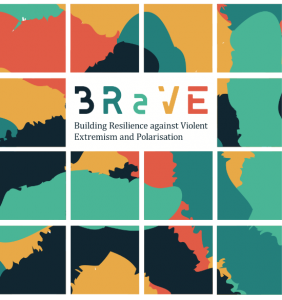This Blog post is the second—the first is HERE—in a four-part series of article summaries from the EU H2020-funded BRaVE project’s First Monday Special Issue exploring societal resilience to online polarization and extremism. Read the full article HERE [Ed.].
By James Fitzgerald
The rise of QAnon presents researchers with a number of important questions. While emerging literature provides insights into how QAnon exists online, there is a dearth of theoretical engagement with the questions of why it exists, and what conditions brought it into being. The open-access journal article on which this post is based seeks to address this gap by contextualizing QAnon as an ontological phenomenon underpinned by anxiety and inquiring into the identity formation strategies employed by the movement.
The growth of QAnon
On 28 October 2017, a user named ‘Q’ began to post ‘highly classified US government secrets’ on 4chan’s /pol/ (politically incorrect) discussion board. Taken individually, the Q drops are mostly rhetorical and often nonsensical. Early musings such as “Why did Soros donate all his money recently?” (28 October 2017) and “Why is POTUS surrounded by generals?” (29 October 2017) may mean little in isolation, but these drops coalesce around specific themes, tend to leverage major occurrences in U.S. politics, and are umbilically tied to the promotion of now former U.S. President Donald Trump as a modern-day saviour.
Sober engagement with the core tenets of QAnon tends to result in reflexive derision and disbelief. Nevertheless, over the course of its existence, QAnon has grown from an obscure sequel to the Pizzagate conspiracy to a global phenomenon that some see as totemic of our ‘post-truth’ ontology. Q adherents have not only run for U.S. Congress but, in the case of Marjorie Taylor Green, have been elected. Of more immediate concern, perhaps, QAnon is implicated in a number of acts of political violence, with the FBI designating it a domestic terrorist threat in 2019. It is also apparent that many of the Capitol Hill attackers on 6 January 2021 were committed QAnon believers, including the infamous ‘Q-Shaman’ (Jacob Chansley), who breached the U.S. Senate Chamber wearing face paint, jogging pants, and a pair of horns.
It fascinates for obvious reasons, but the societal conditions that underpin and sustain its growth remain to be adequately theorised: we possess a substantial understanding of how QAnon exists online, but this needs to be reconciled with why it exists and how it is that communal identity lies at its core. My First Monday article offers a contribution to the puzzle. It begins by examining the importance of ontological identity formation and argues that our collective transition to a more dislocated ‘second modernity’ underlies a global spike in mass anxiety.
Thereafter, conspiracy theories are presented as dynamic simplifying devices that help individuals and communities to address this ontological anxiety, with anti-scientific discourses (which are also hallmarks of second modernity) particularly to the fore. It argues that while the much-vaunted accelerant effect of social media (and the recommender systems therein) significantly contributes to the spread of QAnon content and related falsehoods, its role must be seen as supplementary to underlying processes of ontological identity formation, rather than as causal.
The second half of the paper provides a qualitative (discourse) analysis of the QAnon canon, delving into its core processes of identity formation, with an eye to how it creates a communal feedback loop centered around an emancipatory narrative of morality; a second sub-section investigates how QAnon has interacted with anti-vaxx conspiracies (and vice versa) to enhance the power of its message in the context of COVID-19. It concludes by introducing empathy as a potential avenue for agonistic ‘de-polarization’, recognising that QAnon has been born out of deep ontological fissures that cannot be wholly solved via classic strategies such as content takedowns and de-platforming.
How to solve a problem like QAnon?
The mainstreaming of QAnon — and its association with violence — present a fundamental challenge to states and tech companies alike, with no easy answers. Most strategies for addressing QAnon are focused on tackling disinformation — typically the assumed lifeblood of conspiracy. A recent Brookings Institution report, for example, recommends combating disinformation ‘using data-driven methods’ and the establishment of a non-partisan public-private partnership, but the most significant pushback to date came in mid-to-late 2020 when Facebook and Instagram, Twitter, and YouTube engaged in mass takedowns of QAnon accounts and associated content in an effort to disrupt — if not cripple — the movement.
Politically, this move reflected concerns about extremist discourses in the run-up to the 2020 U.S. presidential election. More substantially, it reflects an Internet policy landscape in which sweeping technological solutions are often applied on the basis of expediency and a tacit assumption that a reduction in extreme(ist) content should translate to an overall reduction in extreme(ist) behaviour and, ultimately, violence.
The long-term efficacy of such policies remains squarely up for debate. In the first instance, we know that mass takedowns have a strong debilitating effect on online social networks and their ability to post further content. On the other hand, explorative research indicates that takedowns may also funnel ‘extreme communities’ towards more ‘extreme spaces’ online, resulting in a hardening of belief systems.
If we are serious about ‘tackling’ QAnon, then it is essential to look beyond networked formations in online spaces — and how to destroy them — and to focus more substantially on its conditions of emergence. The starting point along this process must be a recognition that “the very condition of possibility of the formation of political identities is at the same time the condition of impossibility of a society from which antagonism can be eliminated”; that is, QAnon is not an outlier in contemporary political processes, it is borne of them. Long recognising the silo-ing effects of antagonistic politics, Chantal Mouffe argues strongly for the (difficult) need to shift to agonistic formations of democracy, in which “the crucial issue […] is how to establish [an] us/them distinction, which is constitutive of politics, in a way that is compatible with the recognition of pluralism”.
The key now is to discern how, or indeed if, an empathetic politics of inclusion is possible, particularly when as with classic antagonisms of “terrorism” — the values (and violence) espoused by QAnon are anathema to the very idea of liberal democracy. This is a task that goes far beyond QAnon. When QAnon ‘dies’ — as it surely will — it will be replaced by a similar antagonism that reflects anew the politics and anxieties of our time. We will not be able to explain it away by pointing at ‘the algorithm’, nor will we erase its presence by obliterating online footprints as they take shape. Ultimately, acceptance of this precept might constitute a new form of resilience to (online) polarisation — one which recognises the inevitability of antagonism and the need for a more empathetic, agonistic politics; that is to say, a resilient commitment to dull the sharpest edges of antagonism without erasing them altogether. The next step is to determine what this process might look like in reality and the mammoth task surely entailed.
Dr. James Fitzgerald is Assistant Professor of Terrorism Studies at the School of Law and Government, Dublin City University.
The BRaVE project received funding from the European Union’s Horizon 2020 research and innovation programme under grant agreement number 822189. Image credit: pngtree.

